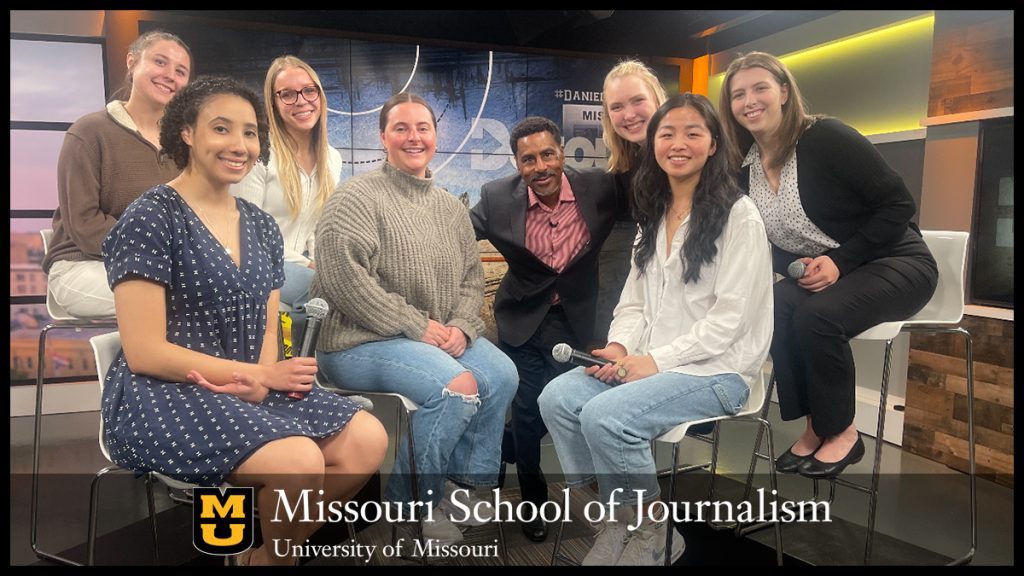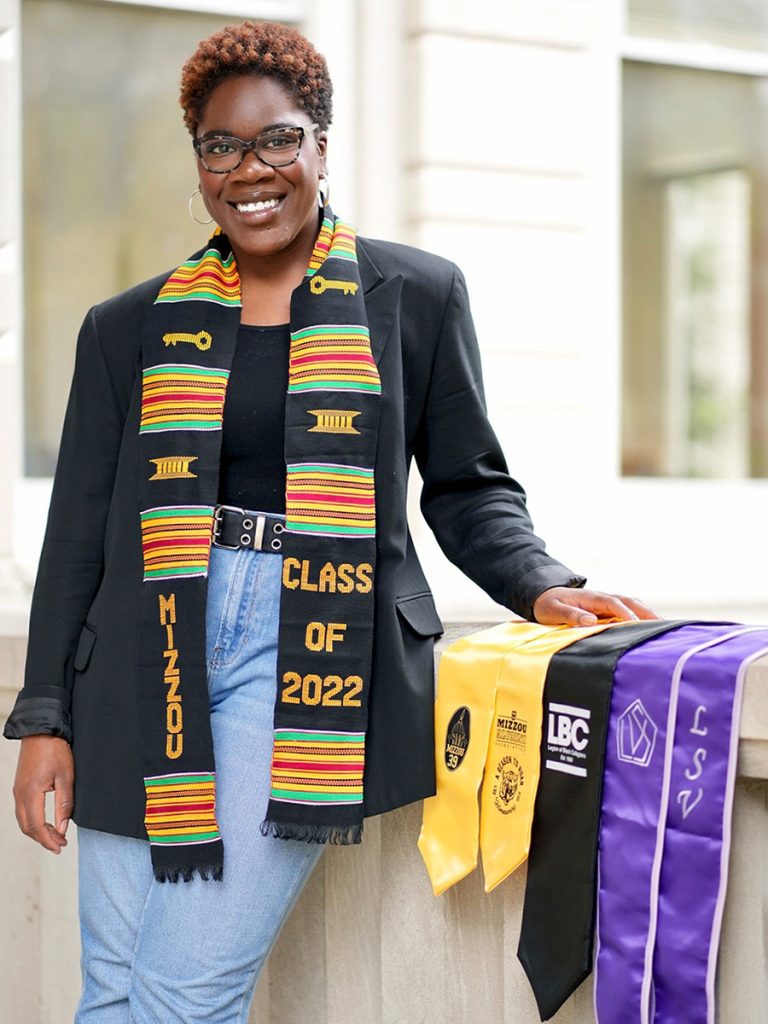DETOUR, Ron Stodghill’s Black travel magazine, expands reach while offering unique opportunities for students at Missouri School of Journalism

Detour student contributors in the RJI studio with founder Ron Stodghill. Back row, from left: Kristin Kuchno, Rylee Fels, Lucy Caile, Taylor Schmitt. Front row, from left: Olivia Gyapong, Brooke Muckerman, Ron Stodghill, Cela Migan
COLUMBIA, Mo. (March 4, 2024) — DETOUR, a digital magazine and multimedia brand focused on Black travel, has grown steadily since its June 2022 launch, and with a slate of new projects on the way, momentum is only growing for the pioneering publication at the Missouri School of Journalism.
DETOUR was developed at the School with the help of a team of student correspondents. The students worked with the magazine’s founder and Meredith Chair in Service Journalism, Ron Stodghill, and his network of industry contacts to create content and establish a voice on social media.
Since then, a distribution partnership with McClatchy has seen DETOUR content published in major outlets like the Miami Herald, the Kansas City Star, the Charlotte Observer and the Fort Worth Star-Telegram, among many others. “Lost in Buckeye,” a series about a father’s search for his missing son in Buckeye, Arizona, reminded readers that “sundown towns” are not just a thing of the past and featured collaborative, multimedia reporting from journalism students.
And now, DETOUR is expanding further into a brand that will encompass a variety of content partners, with plans to partner with and help grow a national luxury lifestyle magazine and a women-led, minority-owned marketing agency. These and other collaborations will complement DETOUR’s existing content from contributors and affinity marketing partnerships, such as with Travel + Leisure Co., the world’s leading membership and leisure travel company.
“Building a successful travel website continues to take us down some surprising roads and introduce us to business models that I would never have imagined,” said Stodghill, an acclaimed, veteran journalist for the New York Times and other publications. “And every day, McClatchy has taught us something new about how to be competitive, and thekind of storytelling that best resonates with audiences.”
One of those new roads is the DETOUR Travel Club, a membership program that will allow readers to save on travel accommodations when it launches soon.
But storytelling is at the root of DETOUR’s mission, so perhaps it is no coincidence that the next big reporting project is called “Rooted,” about an initiative in St. Louis to fight the displacement impacts of gentrification. Nonprofit organization Invest STL is giving 50 Black families $20,000 each to help them build wealth in a three-year process that is part of a larger, multi-decade plan to help Black families stay in the city.
As with “Lost in Buckeye,” DETOUR has enlisted the help of students for “Rooted,” though in a different way.
Working from audio recordings of interviews conducted by Alicia Haywood, an award-winning producer and visiting assistant professor at the School of Journalism, students at KBIA-FM — the Missouri News Network’s NPR member station — are creating a radio series chronicling the St. Louis initiative.
“We’re capturing a moment of trying to reinvest in Black wealth, and we’re trying to understand how people are making meaning out of this 20-year-long project that is just beginning,” said Katelynn McIlwain, BJ ’22, MA ’23, audio managing editor at KBIA.
Five students from a variety of backgrounds and experience levels are working to identify themes in the interviews that they can build episodes around, while students in Stodghill’s capstone course are working on text and video content for DETOUR’s website.
Stodghill and McIlwain hope this is the start of a long-term collaboration between DETOUR and KBIA, and not only for ongoing coverage of “Rooted.”
“The Black experience is obviously something that a lot of newsrooms want to cover, but maybe not every outlet has the resources to dedicate a team just to that,” McIlwain said. “DETOUR has that focus, so it’s a great opportunity for KBIA to have some dedicated coverage to the Black experience.”
Indeed, the outlets share an interest in using “Rooted” as a jumping-off point to explore other stories surrounding gentrification and Black wealth. For example, Stodghill wants to bring attention to the work of Maxine Clark, the founder of Build-a-Bear Workshop. Since retiring in 2013, she has been active in attempting to narrow the “Delmar Divide” that has historically segregated people in St. Louis by race and class.
“I want St. Louis to become a teaching laboratory for students,” Stodghill said. “There are some great, untold stories about people and places shaped by people of color, and we can give them a voice and a platform.”
Of course, large-scale reporting projects aren’t the only instances of student involvement in the publication. Campbell Hamai, an associate producer at DETOUR, earned her bachelor’s degree from the School of Journalism in 2023 and is now a graduate student in the College of Arts and Science. She first met Stodghill in his undergraduate magazine publishing course, and Stodghill, impressed by her work, told her she would have a job upon graduation if she wanted it.
Both as a student and as an employee, Hamai has been struck by Stodghill’s grounded leadership style.
“I’m so used to higher ups emphasizing that there is a power difference, but Ron encourages a relationship where we talk to each other on equal standing,” Hamai said. “He encourages me to say what I’m thinking, even if it contradicts him.”
That culture of support for all voices has also become a positive influence on Hamai’s work.
“I’ve become more aware that, as an editor, I don’t need to be present in a piece,” she said. “Rather than controlling a piece or controlling the author’s voice, I am now very focused on helping authors get their voices out there.”
These sentiments were echoed by Roshae Hemmings, BJ ’22, who started writing for DETOUR as a student in Stodghill’s capstone course before becoming an associate producer for the publication after graduation. But Hemmings added that DETOUR doesn’t just highlight individual voices: by focusing on experiences and opportunities in Black travel, the publication contributes to a broader, more collective sense of understanding about what it means —and what it doesn’t mean — to travel as a Black person.
“We’re trying to show that Black people are avid in this space,” Hemmings said. “There are people who maybe think that Black folks don’t travel to certain places, or maybe there are even Black folks who don’t consider traveling to those places because they haven’t seen other Black people go there. We’re not making a big fuss about it — we’re just showing you that Black people exist in these spaces and have always existed in these spaces.”
Hamai and Hemmings have become key players onStodghill’s team, and their presence is no accident — Stodghill prefers to hand-pick students who can handle a high degree of responsibility and creative freedom.
“DETOUR is a real startup kind of opportunity, and a certain kind of student enjoys that challenge and is ready for that,” Stodghill said. “Roshae and Campbell could not be more different, but I love their drive and theirpartnership.”
In particular, Stodghill is fond of the diverse makeup of his team: Hamai, a woman who is ¾ white and ¼ Japanese from Washington, Missouri; Hemmings, a Black woman born in Kingston, Jamaica, and raised in St. Louis; and Stodghill himself, a Black man from Detroit. Combined with an equally varied constellation of contributors and industry connections, he sees the mix of backgrounds and perspectives as vital for representing DETOUR’s increasingly multicultural audience.
“We’ve had pretty much a rainbow of people working for us since we started,” Stodghill said. “It’s given us some of the healthiest dialogues you can have around race. It’s always thoughtful, and that’s partlybecause of the School of Journalism and the quality of students we have here. If we’re telling good stories, wecan get anyone to show up at the door.”
Updated: March 6, 2024

